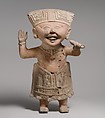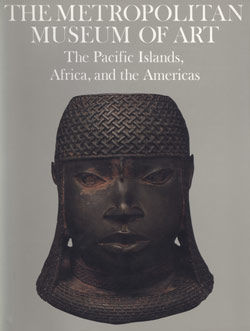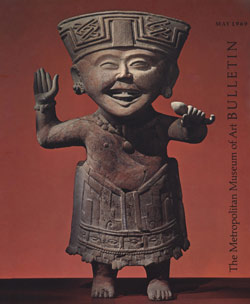"Smiling" Figure
Not on view
Smiling figures (called sonrientes in Spanish) are one of the most intriguing examples of Mesoamerican ceramic artistry, part of a long-standing tradition of hollow ceramic figures produced in south-central Veracruz throughout the Precolumbian period. The animated expression that is responsible for their name is surprising in Mesoamerican art, where emotion of any kind is rarely depicted.
Nude from the waist up, this sonriente wears a cap and skirt covered in geometric patterns, circular earspools, and a beaded necklace and bracelet. He raises his right hand as though in greeting and clutches a gourd rattle in his left. Musicians are depicted playing similar rattles in ceremonial scenes from both Veracruz and the Maya area. Thin red lines drawn below the eyes and the chin, and traces of the black tar paint often used in the region (see MMA 1978.412.59) on the chest represent body paint or tattooing. Additional traces of black paint on the skirt indicate a two-dimensional design once overlaid that in low relief.
All this detailing appears on the front of the figure. In contrast, the back is entirely unadorned, suggesting that the figure was meant to be seen only from the front. Sonrientes like this one are unable to stand on their own, and are too large to be held in the hand. In secondary burials at the Veracruz site of El Zapotal, several smiling figures were interred in a standing position, supported by human skulls and disarticulated bones. If used in ritual before interment, they may have been positioned similarly; their backs placed against some form of support.
Little cloth from Ancient Mesoamerica has survived, but the intricate designs depicted in artistic imagery testify to the importance of textiles and their motifs throughout the region. Here, a combination of low relief and incising is used to represent the details of both cap and skirt. On the cap, a double-edged meander frames interlocking forms that resemble the Aztec glyph for motion (olin). A feather tassel above the forehead is repeated on each side. Actual feathers or other decorative attachments may once have hung from round holes on both sides of the cap. Large step-frets cover the top half of the skirt. Below these, a row of ovoid shapes is bordered by plain bands above and a fringed band below. Three-lobed woven tassels trim the hem.
The first scientific excavations of smiling figures were conducted by Alfonso Medellín Zenil, in 1952, unearthing numerous figures and fragments from rubbish heaps within artificial mounds on the periphery of ceremonial centers. It is unclear whether they had served some ritual function and then been discarded, or were rendered useless and tossed aside because they had been damaged during firing. Most smiling figures lack any information concerning their original context, limiting our understanding of their purpose and meaning.
Sonrientes are most often referred to as male, and those depicted wearing loincloths or with exposed genitalia clearly are (see MMA 1979.206.561). However, authors have disagreed on the gender of others, such as this one, that wear skirts. In both dress and body representation, they do not fit easily into the norms of Mesoamerican representation of the gendered form. Skirts, for example, are usually shown worn by women, although there are exceptions in Maya imagery (see MMA 1979.206.1063). The identification of sonrientes as women is challenged, however, by the fact that artists depict female figures in Veracruz art wearing a garment called a huipil that completely covers the upper body, or with their breasts clearly and naturalistically represented (see MMA 1978.412.73, 1979.206.574). Additionally, the squat proportions and relatively large heads of sonrientes could indicate that they represent either dwarfs or small children. This very ambiguity of gender and age, together with the unusual triangular head shape, suggests that the smiling figures may represent spiritual entities rather than fully-human beings. The discovery of numerous smiling figures in situ in a ceremonial context at the site of El Zapotal lends support to this interpretation.
Excavations at the Mound 2 funerary complex of El Zapotal in the 1970’s unearthed numerous sonrientes undisturbed in both primary and secondary burials of human remains. The U-shaped ceremonial space above them combines architecture, terracotta sculpture, and painting to depict a narrative scene taking place in the court of a death god. The larger-than-life skeletal figure sits at the center of the U-shaped enclosure. Life-sized terracotta figures of standing, bare-breasted women wearing elaborate headdresses are placed to either side as though in procession, their mouths open in song. Other women are seated. Additional attendants are pictured in the wall paintings. Among these are small dwarf-like figures which may represent an earlier version of the chaneque of Mexican folklore who the Mixe-Zoque peoples of southern Veracruz believe serve Chane, the god of the underworld. Cherra Wyllie argues that the sonrientes placed in the burials below Mound 2 may also represent chaneque, placed there to attend or guard the human remains as the chaneque depicted in the paintings attend the death deity.
Patricia J. Sarro, 2018
Further Reading
Heyden, Doris. “Nueva interpretación de las figuras sonrientes, senalada por las fuentes históricas,” Tlalocan, Revista de Fuente para el Conocimiento de las Culturas Indígenas de México, VI:2, Mexico: 1970.
Medillín Zenil, Alfonso. Cerámicas del Totonacapan. Xalapa: Universidad Veracruzana, Instituto de Antropología, 1960.
Medellín Zenil, Alfonso. Nopiloa. Xalapa: Universidad Veracruzana, 1987.
Medellín Zenil, Alfonso, and Frederick A. Peterson. “A Smiling Head Complex from Central Veracruz, Mexico." American Antiquity, Vol. 20, no. 2, pp. 162-169. 1954.
Newton, Douglas. Masterpieces of Primitive Art: The Nelson A. Rockefeller Collection. New York: Alfred A. Knopf, 1978, p. 135.
Nicholson, H.B. et al. Ancient Art of Veracruz. Ethnic Arts Council of Los Angeles, 1971.
Wyllie, Cherra. “The Mural Paintings of El Zapotal, Veracruz, Mexico." Ancient Mesoamerica, 21 (2010), pp. 209-227.
Wyllie, Cherra.” Las Figurellas del Clásico en Veracruz: Reconcideraciones." In Arqueología de la Costa del Golfo. Lourdes Budar, Marciel Liventer, and Sara Ladrón de Guevarra, eds. Xalapa: Universidad Veracruzana, 2017. pp. 161-178.
#1609. Smiling Figure
Due to rights restrictions, this image cannot be enlarged, viewed at full screen, or downloaded.





